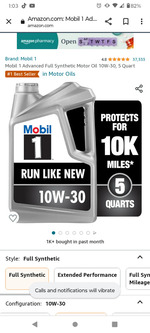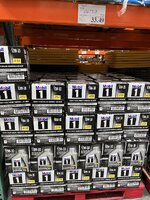You are using an out of date browser. It may not display this or other websites correctly.
You should upgrade or use an alternative browser.
You should upgrade or use an alternative browser.
Can't find M1 10-30
- Thread starter NibbanaBanana
- Start date
Yep. My Walmart has it as well.
Those engines would probably run just fine if you poured canola into the sump instead of 10w30.don't know if Ford changed their specs but my 1993 Windsor V8 has a sticker right on the side of the motor that says "use 10w-30 oil".
The sticker doesn't say which brand to use, just the viscosity.
The sticker on my '93 F-150 says the same. But, if you keep up with TSB's, around 2000 Ford put one out that changed, virtually, all Ford engines to 5w-30.I don't know if Ford changed their specs but my 1993 Windsor V8 has a sticker right on the side of the motor that says "use 10w-30 oil".
NibbanaBanana
Thread starter
I did specifically want M1. Regular old Advanced Formula Full Synthetic. 10w-30. It isn't available at any of my local stores. Can get it online. I did get Quaker State. Wanted M1. Not the end of the world. All my OPE specs 10w-30 for summer use.OK... I thought you wanted M1... but it's obvious you found an alternative, so all is good.
All my OPE, and the ones I service for other people, get WM ST 10w-40 Blend. Better for air cooled engines and no complaints.All my OPE specs 10w-30 for summer use.
Quaker State will do your car just fine!I did specifically want M1. Regular old Advanced Formula Full Synthetic. 10w-30. It isn't available at any of my local stores. Can get it online. I did get Quaker State. Wanted M1. Not the end of the world. All my OPE specs 10w-30 for summer use.
NibbanaBanana
Thread starter
If that's true, then why do the OEM's spec 10w-30?All my OPE, and the ones I service for other people, get WM ST 10w-40 Blend. Better for air cooled engines and no complaints.
Because most OPE manuals were written many, many years ago and have never been updated.If that's true, then why do the OEM's spec 10w-30?
My OPE manuals state only use 30 grade oils and the only recommendation for multi grade is 5w-30 synthetic in extreme cold only and replace as soon as the weather warms ( they use a temperature/oil grade chart). Straight 30 grade is the preferred oil to use in your ..... and will provide many years of reliable use. These manuals were written when fear of oil shearing was prevalent and loss of oil due to use would cause engine mechanical failure. Reminds me of what Ford said about using 5w-20 in my 30 year old truck, in a TSB, that originally called for 10w-30.
I used 30 grade for years in my OPE but 10w40 runs so much better.
NibbanaBanana
Thread starter
It's my understanding that straight 30 weight oil would be fine for a lot of the southern US in most ICE's including autos. The manufacturers spec multi grades because they don't want oil starvation on cold start up. And to make it easier to start a cold engine. The oil spec is designed for the bearing size, clearances and type at operating temperature. I don't know all the factors that determine hydrodynamic bearing design. But I do know that using too heavy an oil can burn up an engine. By experience unfortunately.Because most OPE manuals were written many, many years ago and have never been updated.
My OPE manuals state only use 30 grade oils and the only recommendation for multi grade is 5w-30 synthetic in extreme cold only and replace as soon as the weather warms ( they use a temperature/oil grade chart). Straight 30 grade is the preferred oil to use in your ..... and will provide many years of reliable use. These manuals were written when fear of oil shearing was prevalent and loss of oil due to use would cause engine mechanical failure. Reminds me of what Ford said about using 5w-20 in my 30 year old truck, in a TSB, that originally called for 10w-30.
I used 30 grade for years in my OPE but 10w40 runs so much better.
40w oil is going to have a different viscosity at operating temperature than 30w oil. At operating temperature 10w-30, 5w-30, 0w-30, 15w-30 are all going to have the same viscosity. When new at least. 10w-40 is going to have a different viscosity. I'm sure you can get away with using 40w when 30w is spec'd. But I don't see a reason to do it. I can see a heavier viscosity oil being better in some cases for a slipping bearing. But that's not how a hydrodynamic bearing works.
The manufacturers seem to be trending toward lighter weight oils presumably for tiny benefits in fuel economy. I can see getting away with that. Maybe not as good for high shock load. But using heavier weight I would think would the bearing would need to be redesigned. Again, I don't really know, I'm not a bearing engineer.
wemay
Site Donor 2023
Went to Walmart yesterday and it was there in regular and High Mileage.
Partially correct. Multi grade oils are spec'd for easier start up in cold climates and fuel economy. There is no place for 30 grade oil in today's vehicles. Hasn't been for the past 30 years. The only straight grade spec'd oil today, that I can think of, is 40 grade for Detroit Diesels (designed in the mid 1930's).It's my understanding that straight 30 weight oil would be fine for a lot of the southern US in most ICE's including autos. The manufacturers spec multi grades because they don't want oil starvation on cold start up. And to make it easier to start a cold engine. The oil spec is designed for the bearing size, clearances and type at operating temperature. I don't know all the factors that determine hydrodynamic bearing design. But I do know that using too heavy an oil can burn up an engine. By experience unfortunately.
40w oil is going to have a different viscosity at operating temperature than 30w oil. At operating temperature 10w-30, 5w-30, 0w-30, 15w-30 are all going to have the same viscosity. When new at least. 10w-40 is going to have a different viscosity. I'm sure you can get away with using 40w when 30w is spec'd. But I don't see a reason to do it. I can see a heavier viscosity oil being better in some cases for a slipping bearing. But that's not how a hydrodynamic bearing works.
The manufacturers seem to be trending toward lighter weight oils presumably for tiny benefits in fuel economy. I can see getting away with that. Maybe not as good for high shock load. But using heavier weight I would think would the bearing would need to be redesigned. Again, I don't really know, I'm not a bearing engineer.
10w-40 oil is not too thick and not going to burn up an OPE engine. Remember, I'm talking about 10w-40 which will lubricate you engine easier and faster than a straight 30, especially in colder temperatures. I believe it will also protect your hot running air cooled OPE better. OPE, generally, have sloppy tolerances/clearances.
It's your choice and not a bad one. I'm just going by 60 years of experience with them.
Is the PQIA a registered trademark?Went to Walmart yesterday and it was there in regular and High Mileage.
Not necessarily true. It all depends on the base oils used.In theory, the benefit of a 10w30 is less VII and lower Noack. Some have reported in the past that when switching from a 5w30 to a 10w30 their oil consumption dropped.
That's why I said in theory. It depends on the base oil blend. More often than not the Noack is lower in a 10w30 than a 5w30.Not necessarily true. It all depends on the base oils used.
wemay
Site Donor 2023
You might be right...Is the PQIA a registered trademark?
NibbanaBanana
Thread starter
There's a few manufacturers that still sell straight 30W HD motor oil. Including Shell, Castrol, Pennsoil, When I was a kid, in the 1960's and 1970's, I would say that for those who thought about such things, more often than not, the opinion was that straight 30W was the best protection for your motor. At least if your local temperature was okay for it's use.Partially correct. Multi grade oils are spec'd for easier start up in cold climates and fuel economy. There is no place for 30 grade oil in today's vehicles. Hasn't been for the past 30 years. The only straight grade spec'd oil today, that I can think of, is 40 grade for Detroit Diesels (designed in the mid 1930's).
10w-40 oil is not too thick and not going to burn up an OPE engine. Remember, I'm talking about 10w-40 which will lubricate you engine easier and faster than a straight 30, especially in colder temperatures. I believe it will also protect your hot running air cooled OPE better. OPE, generally, have sloppy tolerances/clearances.
It's your choice and not a bad one. I'm just going by 60 years of experience with them.
I don't remember auto manufacturers spec'ing a specific viscosity so much but I do remember a lot of people using temperature range charts. I think they said that straight 30W was good down to freezing 32F, 10W-30 was good to 0F, and 5W-30 below that. I remember 10W-40 being on the chart but don't remember the range. Might have overlapped 10W-30 though.
Now all the manufacturers specify exactly what to use.
I knew a very good professional auto mechanic in middle Tennessee who used 30W oil in his vehicles and recommended it. He said it was fine for the temperature ranges they saw. This was in the early 1990's.
Completely agree that you wouldn't want to use it anywhere in the cooler parts of the US. But not at all convinced that it wouldn't be as good or better than multi-viscousity for hot regions.
Similar threads
- Replies
- 35
- Views
- 3K
- Replies
- 18
- Views
- 3K
- Replies
- 43
- Views
- 6K
- Replies
- 37
- Views
- 3K



